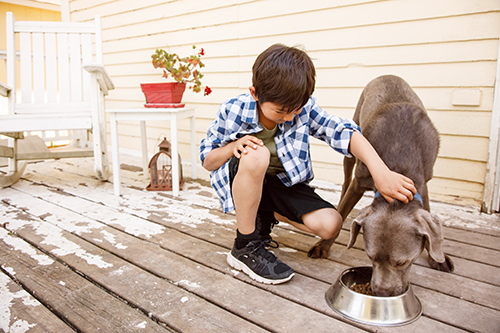Fast Eating Pets

When it comes to mealtime for pets, some eat too fast, a few eat too slow and some are just right. Just right and too slow are rarely a problem, so this article will discuss those that eat too fast.
Chewing performs a vital function. It physically breaks up food, increasing its surface area for more complete digestion. Unlike people, dog and cat saliva does not contain enzymes to begin the digestion process. However, chewing and mixing food with saliva, softens it, and aids in swallowing. Finally, chewing helps to physically remove some of the plaque from teeth before it can harden into tartar.
For those that eat too fast, there can also be dangers. Some can choke, gag and/or vomit. On occasion, gagging or vomiting can lead to aspiration of food particles and pneumonia. Dogs that eat too fast or gulp their food can also swallow air. This can contribute to a medical condition called bloat where the stomach can become distended with air. In some dogs, especially deep chested breeds, gas distention can lead to a twisting of the stomach. This is a life-threatening condition called Gastric Dilation and Volvulus (GDV).
If you have a fast eater, here are some suggestions that may help.
Small Meals: For those who work at home, feeding 4-6 smaller meals a day, rather than one or two, can reduce rapid eating by never allowing a pet to become too hungry.
Object Barriers: One of the simplest ways of slowing down eating is to provide a physical barrier in the feeding bowl. For dogs, place large stones that they cannot possibly swallow in the bowl with the food. For cats, stones or large glass marbles work well.
Slow Feeder Bowls: These are bowls that have plastic projections or “fingers” that extend up from the bottom. The idea being that the dogs or cats must slow down and use their tongues more to get the food and cannot gulp. Various types are available and they all work well.
Food Puzzles: These feeding games contain nooks, crannies and slots for food to fit into. Some lay flat and some dispense food while dogs and cats play with them. It makes it impossible for pets to gulp food and provides mental stimulation to your pet.
Baking Pans: Cookie sheets or muffin pans work well. Food can be spread out on a cookie sheet or placed in the muffin cups. This forces pets to eat pieces individually using their tongue, slowing down their eating speed and eliminating gulping.
Hand Feeding: While many of us may not have time for this, for those who do, it is a good way to slow down eating. Mealtimes can be combined with training sessions, using the kibble from the meal portion as a reward.
Hide and Seek: This is done by hiding small amounts of food in different places in a fenced backyard for dogs or in the house for dogs and cats. This appeals to their hunting instinct as well as slowing down their eating.
Some of these techniques also work well for pets that eat canned food, but it is important to wash containers well after each feeding.
